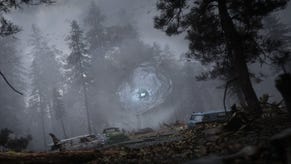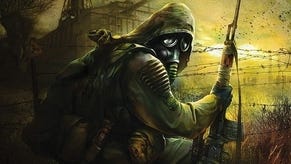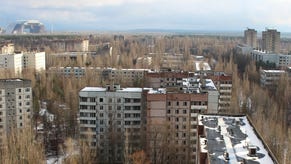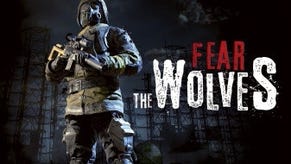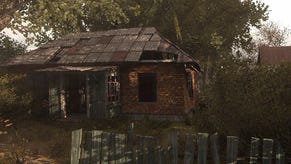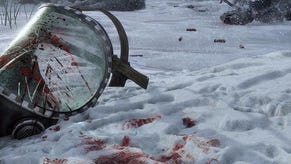S.T.A.L.K.I.N.G. Heads
Shadow of Chernobyl men talk Zones and A-Life.
With S.T.A.L.K.E.R. Shadow of Chernobyl edging closer to it's first quarter 2007 release, publisher THQ and developer GSC Game World made a full showing of the near-complete game in Ukrainian capital Kiev late last month. Making its first public appearance with its final structure, S.T.A.L.K.E.R. showed itself to be a feature-heavy FPS which compromises between GSC's original ideal of a totally scriptless, randomised "adventure" through the 30km exclusion zone around Chernobyl's ill-fated Reactor 4, and fully scripted, story-driving levels.
The game casts the player as a S.T.A.L.K.E.R., a mercenary working in the radioactive nightmare left by the mid-'80s disaster. While you generally busy yourself with hunting for artefacts in the Zone to sell in the outside world, going up against other S.T.A.L.K.E.R.s, mutants and the military in a huge and well-varied green-scape, the events of the game see you waking up in a hut with two surly men and a healthy dose of amnesia. You should probably insert your own "Ukrainian vodka" gag. You're tasked with solving the riddle of the Zone with a boat-load of guns and 60 spare hours. The game's size has certainly been a factor in the length of its gestation period.
In fact, S.T.A.L.K.E.R.'s development saga has taken the game from "massively anticipated" to a post Half-Life 2 curio with plenty to prove. Project lead Anton Bolshakov gave us a decent look at the game's 'A-Life' system - a feature that governs all freely roaming life in the game-world - and PR chap Valentine Yeltyshev filled in gaps about the game's long-delayed release and what's next for Ukraine's most prominent developer.
Anton Bolshakov: A-Life is a unique feature of our game. This is the AI module which controls all life within the Zone, including individual S.T.A.L.K.E.R.s and all the monster life.
This life simulation takes care of how S.T.A.L.K.E.R.s lead their normal lives, moving around, collecting artefacts, going on missions, communicating with each other, taking food, taking rest, and so on. It also controls the life cycle for monsters. They also take rest, go hunting, eat dead bodies and do whatever else monsters would need to do there in the Zone.
On a global level, A-Life coordinates the relationships between S.T.A.L.K.E.R. factions and the monster population, such as one faction attacking another or a monster population migrating and conflicting with a S.T.A.L.K.E.R. grouping.
For this demonstration, we've prepared a level called Garbage, the second in the game. This level is adjacent to the Zone's border, the level where the first artefacts show up. There are loads of S.T.A.L.K.E.R. newbies here trying to find their first artefacts. According to the story, bandits try and exert influence and power on this level to control the movement of artefacts.
Initially the level is filled with characters and elements that are important to the game's story. Here you can see a camp of bandits and a vehicle cemetery where S.T.A.L.K.E.R.s reside. We've created a special command to show you how the A-Life simulation works in the game. [As he says this, Bolshakov goes to top-down a 2D map of the entire game-world.] This is the Zone map and this is the level where we're now located.

We have a special command that highlights all S.T.A.L.K.E.R.s and monsters in the game. [The map becomes covered with coloured dots.]You can see every level and every living thing in it. In total the game controls over 1,000 S.T.A.L.K.E.R.s and monsters, 1,000 characters. As I mentioned, initially we've filled this level with the needs of our story. As all the interesting spots on the level are filled, the A-Life simulation is quite stable, and migration between levels is not that high. To shake the balance of the system, there's another special command to kill all the characters on the level. [Anton presses a button and all the dots in our level vanish.]
So we've killed everything on this level. There are no characters left. Now I'll speed up time. You can see how S.T.A.L.K.E.R.s from other levels start filling up this area. Monsters come first because they're the fastest to move. Now we'll wait for a while until the levels fills up then we'll fly around and see what's going on. Actually, killing everyone on the level is comparable to me going through the story of the game. We can see how the level gets filled by other characters after I've completed the story part.
Putting the time speed back to normal, we can see that events are now taking place in the level. [Goes back to 3D and flies around the level, which is largely made of undulating hill covered with shrubs] We can hear a gunfight. We're seeing bandits fighting with the military here.
So when you complete the game and return to a level it's not going to be empty. You can actually observe the life going on in the level. See, there's a monster eating a body. It's not very peaceful. This is all completed coordinated by the A-Life system. None of this is scripted. It's randomised.
The core idea behind this system is that if you return to a level you previously completed it's never empty. Say, in a factory you previously fought a group of bandits, you could return later to find it populated by hostile or friendly S.T.A.L.K.E.R. groupings. You can do more side quests, pick up more artefacts on these levels, and so on. This greatly increases the replayability and randomness factor.
This system is closely related to the Random Task System. Say a camp of bandits gets together in an open area on a level: a series of random tasks closely linked to bandits is generated. For example, you can destroy bandit camps and rob them. So the whole thing is interesting to look at and be part of, and this increases a lot the fun factor and interest in the gameplay.
Completing the story in S.T.A.L.K.E.R. doesn't mean that the game is over.
This feature has never been done before in a game. It took a lot of experimentation. This, of course, caused the delay for the game's release. It's a critical feature. The original idea was to create a totally randomised game, but it took us time to realise that it's just impossible to do. We then had two options: either we did a totally scripted game or we tried to preserve this life simulation. We found a way to combine the two elements in the right way.
Yes, we're really counting on this feature as being one of the most interesting in the game, but on top of that there are plenty of others. We have RPG elements, communication and trade. There are seven different endings and depending on how you play you'll reach a different one. It's a pretty much open-ended game. A bunch of these features put together I think will determine a unique positioning for S.T.A.L.K.E.R.
We've got five false endings and two true endings. You don't continue playing, you can only replay. It really boils down to how you play it and which decisions you make as to which ending you reach. It's kind of interesting to replay it in a different role, to play it from a different perspective and reach something else. Also, taking into account the A-Life system, every play through is going to be different.
In the game we have the primary storyline and a secondary storyline. There are hidden riddles and puzzles. If the player goes strictly through the main story without taking any guesses and any other clues, he will reach one of the false endings. However, if he takes care to find other the ways, clues and solutions of the secondary story, he will reach one of the true endings.

The ending will correspond to the way you behave through the game, to your personality in a way, speaking about false endings specifically. If you've been helping people, or killing them all, if you've been trading a lot or been greedy: the ending will represent that. The true ending is to find the puzzle of the Zone, finding out the riddle of what generates the Zone and what's behind it.
The time when development here was cheap is now gone, so our budgets for development are now comparable to European or American budgets. For any developer it's important to have a big, well-established partner like THQ to work with. Including us.
All developers are dreamers by default so having a publisher look into things helps a lot to speed things up, to move properly along a development schedule: it's very important to have this cooperation. Especially for S.T.A.L.K.E.R.
Well, interesting and a little bit scary for us because we're making the game that many players dream of. So we're scared of not giving them the game they expect it to be. We are interested in adding sounds to the game and making a great atmosphere, so the atmosphere will be completely OK. It's outstanding. But there will people that will not like, for example, the gameplay and there will be people that like it completely. We are making the game that we understand it to be, a game that we want to play ourselves. So we're making a good game for us, for our taste.
I think that the latest changes will make the game more interesting for more people. We've made the gameplay more active, more unpredictable, interesting, not just boring surfing through the Zone. We've implemented a great storyline that will always surprise the player with interesting turns and events.
I don't think I'm allowed to talk about that, so that's a question for our director or vice president. We're planning to develop games in the future, so S.T.A.L.K.E.R.'s not the end.

